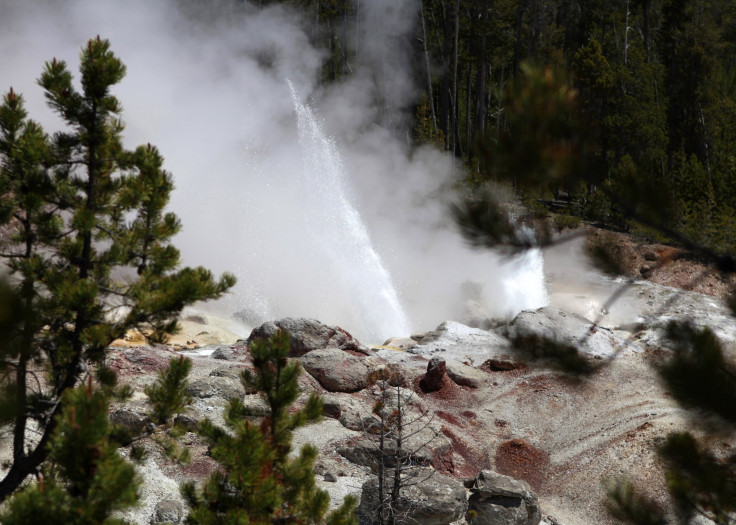Yellowstone 'Big One'? Researchers Say 'Reawakened' Geyser Doesn't Point To Impending Eruption
KEY POINTS
- Scientists are on the lookout for signs of a possible Yellowstone eruption
- Recent "reawakened" geyser activity sparked fears of an impending eruption
- A team of researchers "didn't find any evidence" of a big Yellowstone eruption coming soon
Recent geyser activity at Yellowstone National Park's Steamboat Geyser sparked fears that the supervolcano may be working its way toward "the big one," but a team of researchers said that the geyser's "reawakening" doesn't mean that a Yellowstone eruption is on its way.
It was in March 2018 when Steamboat Geyser began erupting again after over three years of being dormant. It has erupted many more times since then, erupting 38 times in 2018 and 48 times in both 2019 and 2020, the U.S. Geological Survey said in a recent update on Yellowstone's activity.
This naturally sparked fears that the eruptions may have been a result of magma activity signaling an impending eruption. And with the supervolcano not having erupted 70,000 years, scientists are always on the lookout for signs of "the big one."
But according to the researchers of a new study to be published in Proceedings of the National Academy of Sciences, there is so far no indication that the Geyser's reawakening is a sign that Yellowstone is erupting soon.
"We don't find any evidence that there is a big eruption coming. I think that is an important takeaway," the study's senior author, Michael Manga of the University of California, Berkeley, said in the university news release.
As the news release explained, the researchers aimed to answer three questions in their study:
"Why did it reawaken? Why is its period so variable, ranging from three to 17 days? And, why does it spurt so high?"
Among these, the researchers found the answers to the latter two, but not the first one.
'Why Is Its Period So Variable, Ranging From Three To 17 Days?'
To answer this question, the researchers looked at the data on Steamboat Geyser, both from its past active and dormant periods as well as its activity starting from its reawakening in 2018. They also looked at the data from other Yellowstone geysers.
Overall, the researchers found that snowmelt and rainfall were likely related to why geyser activity has such a varied range. In other words, the geyser activity appears to be "seasonal."
"During the latest active phase, we observed a peak in the number of eruptions each year during the late spring (May) through the midsummer (July), coincident with the increase in river discharge following snowmelt," the researchers wrote in the study.
This shows how the conditions can affect geyser activity.
It was also Manga and his team that recently found evidence that the prominent Yellowstone geyser, Old Faithful, actually stopped erupting some 600 to 800 years ago, with the dormant period lasting for about 80 years. Based on their findings, it's possible that the dormancy was because of a serious drought at the end of what's known as the "Medieval Climate Anomaly."
'Why Does It Spurt So High?'
Steamboat Geyser is "the world's tallest active geyser," the researchers noted in the title of their study. To find why Steamboat Geyser's eruptions are so tall, the team compared its eruptions to that of other geysers in the U.S., Chile, Russia and Iceland, and found a pattern: deeper reservoirs make higher eruption jets.
In the case of Steamboat Geyser, its reservoir is about 25 meters into the ground, much deeper compared to the other geysers'.
"The deeper you go, the higher the pressure. The higher the pressure, the higher the boiling temperature. And the hotter the water is, the more energy it has and the higher the geyser," Manga explained in the news release.
'Why Did It Reawaken?'
The researchers were unable to determine exactly why Steamboat Geyser reactivated in 2018, finding little to no evidence linking it to external factors such as annual precipitation rates or seismic activity. However, they also didn't find "definitive" evidence that it was because of new magma activity. What's more, no other dormant geysers became active at the time.
It's possible, the researchers explained, that the reawakening could be because there were changes in the "internal plumbing" of the geysers.
"Steamboat's reactivation may arise from processes that operate purely within its local hydrothermal system," the researchers wrote. "Geyser activity is highly dependent on permeability of the conduit and surrounding rock matrix."
Although the researchers couldn't find exactly what caused the geyser's reactivation, such studies provide significant information on potentially dangerous geysers and volcanoes. As the National Park Service explained, it is so far "impossible" to predict when most geysers will erupt because of "constantly changing factors."
"Hydrothermal explosions — basically hot water exploding because it comes into contact with hot rock — are one of the biggest hazards in Yellowstone," Manga said in the news release. "The reason that they are problematic is that they are very hard to predict; it is not clear if there are any precursors that would allow you to provide warning."

© Copyright IBTimes 2024. All rights reserved.






















